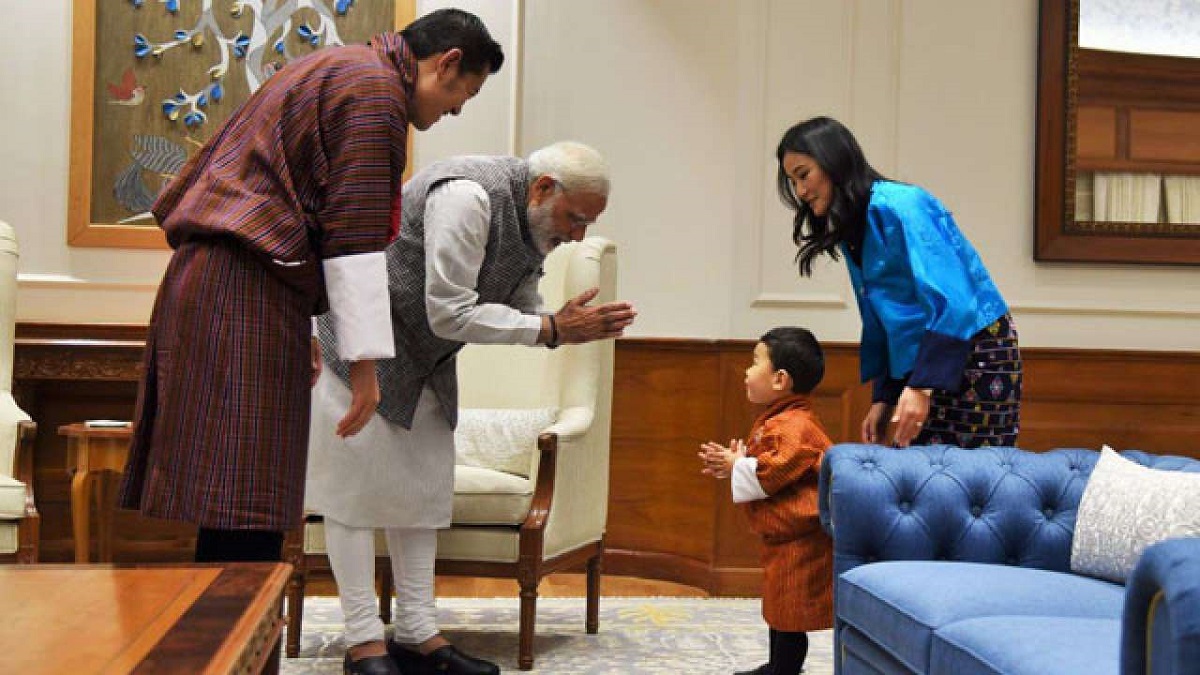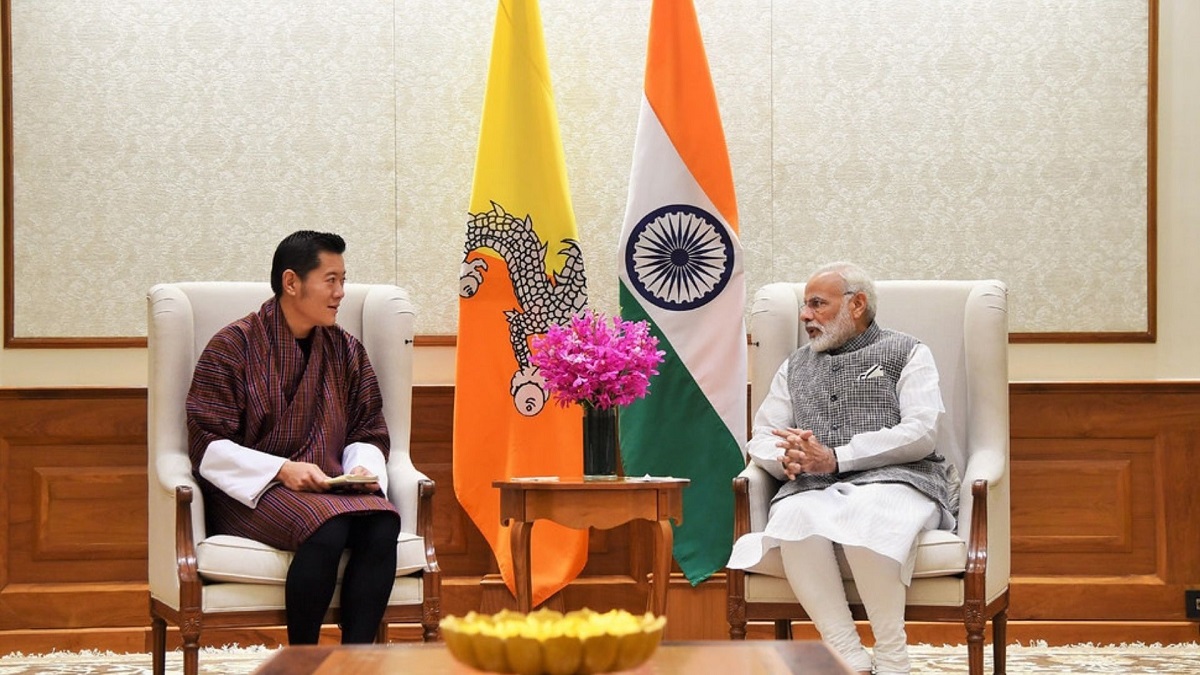
Bharat for Bhutan and Bhutan for Bharat
During his maiden foreign visit to Bhutan in June 2014, Indian Prime Minister Narendra Modi vowed to nurture bilateral relations which he described as ‘B4B — Bharat for Bhutan and Bhutan for Bharat’ as he held discussion with an entire gamut of ties with the Bhutanese King and the Premier, Jigme Khesar Namgyel Wangchuck. India has Neighbourhood First- foreign policy priority and Bhutan is always special.
India and Bhutan have a close civilisational, cultural and economic relationship that dates back centuries. For Bhutan, India is gyagar (the holy land) as Buddhism originated in India and is followed by almost all the Bhutanese. Both countries cherish their strong friendship which is based on mutual trust, cooperation and goodwill. The ties between the two countries were further nurtured after the establishment of diplomatic relations between India and Bhutan in 1968.
The basis of this relationship is formed on the pillars of the Indo-Bhutan Friendship Treaty of 1949 which emphasises ‘perpetual peace and friendship, free trade and commerce, and equal justice to each other’s citizens’. The relationship takes a greater salience given that India shares a 699 km long boundary with Bhutan, with four Indian states viz. Sikkim, West Bengal, Assam and Arunachal Pradesh have international borders with Bhutan. Bhutan is also a key player in two of India’s important foreign policy elements – Neighbourhood Policy and Act East Policy. Thus, a close commercial, cultural and connectivity integration with Bhutan is key to India’s Northeast States’ development as well.
India has always kept Bhutan’s socio-economic development and its territorial integrity as a key plank in its foreign policy agenda. Significant assistance has been provided in wide-ranging areas including cultural exchanges, hydropower, trade, education, and socio-economic development. India is not only Bhutan’s biggest development partner but also the most important trading partner both as a source and market for its trade in goods and services. India provides not only the transit route to a landlocked Bhutan but is also the biggest market for a number of Bhutan’s exports including hydroelectricity, semi-finished products, ferrosilicon, and dolomite.
However, there is a growing shadow of nefarious Chinese designs on the India-Bhutan relationship. China perceives Bhutan’s foreign policy for China as influenced by India’s dominance and control. China, therefore, has been employing a coercive strategy to achieve its objectives with Bhutan. Some of the Bhutanese scholars even see China’s acts of intimidation such as the flaring up of territorial disputes as a means to punish Bhutan for being aligned with India.
Historically, Bhutan had a very close relationship with Tibet. However, the relationship underwent a drastic change after China invaded Tibet in 1949. The threat was imminent as Mao Zedong laid claim to Bhutan as Chinese territory. China’s new maps of 1954 and 1958 and the illegal occupation of 300 square miles of Bhutanese territory further aggravated the apprehensions about Chinese designs on Bhutan.
As per Bhutan’s request, India deployed its Military Training Team (IMTRAT) in Bhutan to train the Bhutanese security forces in 1961 and since then has been responsible for Bhutanese security. A number of engagements pertaining to security and border management issues, threat perceptions, coordination of Indo-Bhutan border entry-exit points, sharing of real-time information, among other aspects are being undertaken by the two countries on a regular basis. The Doklam standoff between Indian and Chinese forces in 2017 has made the security matter even more important and calls for even better coordination and partnership between Indian and Bhutanese forces to secure the strategic areas.
The cornerstone of Indo-Bhutan relations has been the development cooperation and hydroelectricity generation has remained at its core. The two countries have reiterated their commitment to jointly develop 10,000 MW of hydroelectricity capacity in Bhutan. The completion of the 720 MW Mangdechhu hydropower project in Bhutan has been deemed an achievement of the partnership between the two countries. This has propelled discussions of the Sankosh Hydropower Project building between the two countries. Moreover, the first-ever joint venture project – the 600 MW Kholongchhu hydropower project – was commissioned by the two countries even amidst the COVID-19 pandemic. The project is aimed at generating surplus hydroelectricity for Bhutan which will be exported to India aiding Bhutan’s revenue as well as employment generation.
India’s assistance to Bhutan’s development is not limited to the hydropower sector but encompasses almost all the sectors including education, infrastructure, social services, and technology advancement, amongst others. For Bhutan’s 12th Five Year Plan (2018-2023), India will be providing grant assistance of Rs. 4,500 crores, along with a transitional Trade Support Facility of Rs. 400 crores over a five-year period to strengthen the economic linkages.

India adheres to the non-reciprocity principle with Bhutan and has been sensitive to Bhutan’s distress during the COVID pandemic. As a friendly neighbor, India has been responsive to Bhutan’s needs exemplified by the support extended to Bhutan by way of supply of essential goods, testing kits, medicines and vaccines even during the trying times for India itself.
The recent launch of a joint India-Bhutan SAT satellite by ISRO marks a new era of India – Bhutan relations. This satellite is expected to enable Bhutan by providing real-time data and high-resolution images for land mapping and facilitate managing its natural resources, forests and agriculture. This development is in line with the growing India-Bhutan relations in new avenues such as advanced technology, space and digital systems.
Already, several key initiatives have been launched in the fields of digital and space, such as RuPay, the integration of Bhutan’s DrukREN with India’s national Knowledge Network and the establishment of Ground Earth Station by ISRO to harness the services of South Asia Satellite. Thus, India is enabling the development of Bhutan’s digital and space infrastructure so as to harness the potential of Bhutanese youth via skill development and employment generation. Through digital and space cooperation, not only India is spreading its technological footprint, but Bhutan is also benefitting from India’s investments and expertise in bringing about transformation in these sectors in Bhutan.
The bilateral ties between the two countries have over time matured into comprehensive partnerships and cooperation on a wide range of issues spanning hydropower, trade and commerce, security and intelligence sharing, education, culture, space and digital sectors, amongst others. This relationship is a mutually beneficial relationship based on trust, shared cultural values and equality. The bonding has been further reinvigorated by the primacy accorded to the relationship by PM Narendra Modi reflected in the vision of B2B (Bharat to Bhutan) and B4B (Bharat for Bhutan and Bhutan for Bharat) to take the cultural, political and economic ties between the two countries to greater heights.
This article has been analyzed on the basis of news and opinions published by reputed writers in various established media of India.















Comments